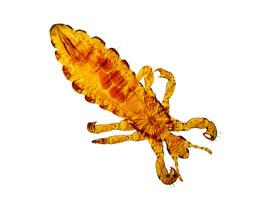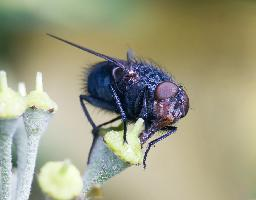
Description de l'animal
The Body Louse, scientifically known as Pediculus humanus, is a small, parasitic insect that primarily inhabits the clothing of humans, from where it frequently moves onto the skin to feed. This species is closely related to the head louse (Pediculus humanus capitis) and the pubic louse (Pthirus pubis), but it is the body louse which is particularly notorious for its role in transmitting various diseases among humans.Typically measuring about 2.3 to 3.6 mm in length, body lice are slightly larger than head lice. They possess a dorsoventrally flattened body, which is an adaptation for their lifestyle, allowing them to move with ease through the fibers of clothing or hairs on the human body. Their color can vary from whitish to grey or even slightly brown, depending on the amount of blood ingested. Like all lice, body lice have six legs, each equipped with claws that are perfectly adapted to grasp onto the fibers of clothing or human hair.
The lifecycle of the body louse consists of three stages: egg (nit), nymph, and adult. Females lay their eggs on clothing fibers or, less commonly, on body hair. These eggs are firmly attached to the fibers with a glue-like substance and hatch within about one to two weeks, depending on the environmental conditions. The emerged nymphs undergo three molting stages before becoming adults, a process that takes about 7 to 10 days. Adult lice can live for up to 30 days on a host. During their lifetime, females can lay up to 300 eggs, ensuring the perpetuation of the species.
Body lice feed on human blood and require regular feeding to survive. Their bites can cause intense itching and irritation of the skin, leading to scratching. Persistent scratching can result in secondary bacterial infections. Moreover, body lice are vectors of several serious diseases, including typhus, trench fever, and relapsing fever. These diseases are transmitted when infected feces from the lice are scratched into the skin or mucous membranes, or when crushed lice or their feces come into contact with open wounds.
The spread of body lice is closely associated with overcrowding and poor hygiene, conditions that are often found in situations of poverty, war, and natural disasters. Unlike head lice, which are spread primarily through direct head-to-head contact, body lice can spread through shared clothing, bedding, or close contact with an infested individual.
Prevention and control of body lice infestations involve maintaining good personal hygiene, regular washing of clothes and bedding at high temperatures, and avoiding sharing personal items. In cases of infestation, treatment typically involves the use of topical insecticides and thorough cleaning of all clothing and bedding. In areas where body lice are known to transmit disease, public health measures focus on improving living conditions and access to proper sanitation facilities to reduce the risk of infestation and disease transmission.
In summary, the body louse is a parasitic insect with significant implications for human health, especially under conditions that favor its spread. Understanding its biology and lifecycle is crucial for the development of effective control measures and prevention of the diseases it can transmit.
Animaux similaires
Nouvelles photos d'animaux
Top 10 des animaux
- Dolphin gull (Leucophaeus scoresbii)
- Japanese macaque (Macaca fuscata)
- Greek tortoise (Testudo graeca)
- Stone loach (Barbatula barbatula)
- Galápagos tortoise (Geochelone nigra complex)
- Russian tortoise (Testudo horsfieldii)
- Diana monkey (Cercopithecus diana)
- Moustached guenon (Cercopithecus cephus)
- Common flying dragon (Draco volans)
- Galápagos penguin (Spheniscus mendiculus)


